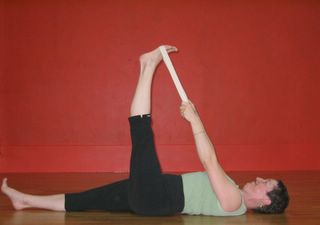Stability and Freedom
Try this on for size: every yoga pose is an expression of the interplay between stability and freedom.
What most of us seem to want is more freedom in our yoga poses. We want our noses to miraculously reach down and rest on our shins in parsvottanasna.

So beautiful. To see more of these beautiful pics, click here.
We want our hips to open up so we can do the splits (hanumanasana). In supta padangusthasana, we want our top legs to just fold back and rest on our chests. (Supta padangusthasana is lying down and, with straight legs, grabbing a big toe.)

supta padangusthasana
That's freedom. When you can move like that, you're really open.
It's ironic that this sort of freedom is an outgrowth of stability. Your nervous system won't allow it any other way.
When your body is stable, firmly connected to the earth, your nervous sytem perceives it and feels safe. When you're safe, you don't need to guard. You can release and be free to open up in the pose.
The mind is tricky. It's easily drawn to bold, brash movements. So the mind focuses on freedom. The mind is distracted by the top leg that cuts a wide swath through the air.
But if you want freedom, you'll have to focus your mind on stability.
In supta padangusthasana, if you want your top leg to be free to pull back onto your torso, you've got to focus on the other leg, the one that's down on the ground.
Most of us are so drawn to the top leg we don't even notice that when we draw it back, the bottom leg lifts away from the floor...and loses stability.
So start the pose again, this time concentrating on keeping the back of the bottom thigh always in contact with the ground. At first you won't be able to take your top leg very far back. But soon you'll go farther than ever before as your nervous sytem begins to trust you to keep the pose firmly grounded.
And don't forget. It's not just true of supta padangusthasana. You can focus on the stability of any pose to get the freedom you desire.
Don't just read about it. Get up. Experience it. Experience yoga!
Kevin Perry
www.ExperienceYoga.org
p.s., Supta means 'supine,' or literally, 'to sleep.' Pada is 'foot,' or 'leg.' Angustha is my favorite Sanskrit word. It means 'big toe.' Asana is 'pose.' So, supta padangusthasana means 'lie down on your back and reach out to grab the big toe on the end of your leg pose.'
Getting a grasp on the Sanskrit names of yoga poses is as easy as grabbing your angustha. You can do it. It's fun when you experience it. Click here to find out more about our Experience Sanskrit workshop coming up June 25, 2005 at the Saint Louis YogaSource.
Copyright 2005. All rights reserved by Mo Yoga LLC.
What most of us seem to want is more freedom in our yoga poses. We want our noses to miraculously reach down and rest on our shins in parsvottanasna.

So beautiful. To see more of these beautiful pics, click here.

We want our hips to open up so we can do the splits (hanumanasana). In supta padangusthasana, we want our top legs to just fold back and rest on our chests. (Supta padangusthasana is lying down and, with straight legs, grabbing a big toe.)

supta padangusthasana

That's freedom. When you can move like that, you're really open.
It's ironic that this sort of freedom is an outgrowth of stability. Your nervous system won't allow it any other way.
When your body is stable, firmly connected to the earth, your nervous sytem perceives it and feels safe. When you're safe, you don't need to guard. You can release and be free to open up in the pose.
The mind is tricky. It's easily drawn to bold, brash movements. So the mind focuses on freedom. The mind is distracted by the top leg that cuts a wide swath through the air.
But if you want freedom, you'll have to focus your mind on stability.
In supta padangusthasana, if you want your top leg to be free to pull back onto your torso, you've got to focus on the other leg, the one that's down on the ground.
Most of us are so drawn to the top leg we don't even notice that when we draw it back, the bottom leg lifts away from the floor...and loses stability.
So start the pose again, this time concentrating on keeping the back of the bottom thigh always in contact with the ground. At first you won't be able to take your top leg very far back. But soon you'll go farther than ever before as your nervous sytem begins to trust you to keep the pose firmly grounded.
And don't forget. It's not just true of supta padangusthasana. You can focus on the stability of any pose to get the freedom you desire.
Don't just read about it. Get up. Experience it. Experience yoga!
Kevin Perry
www.ExperienceYoga.org
p.s., Supta means 'supine,' or literally, 'to sleep.' Pada is 'foot,' or 'leg.' Angustha is my favorite Sanskrit word. It means 'big toe.' Asana is 'pose.' So, supta padangusthasana means 'lie down on your back and reach out to grab the big toe on the end of your leg pose.'
Getting a grasp on the Sanskrit names of yoga poses is as easy as grabbing your angustha. You can do it. It's fun when you experience it. Click here to find out more about our Experience Sanskrit workshop coming up June 25, 2005 at the Saint Louis YogaSource.
Copyright 2005. All rights reserved by Mo Yoga LLC.


0 Comments:
Post a Comment
<< Home